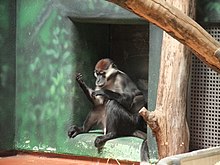Collared mangabey
| Collared mangabey[1] | |
|---|---|

| |
| Scientific classification | |
| Domain: | Eukaryota |
| Kingdom: | Animalia |
| Phylum: | Chordata |
| Class: | Mammalia |
| Order: | Primates |
| Suborder: | Haplorhini |
| Infraorder: | Simiiformes |
| Family: | Cercopithecidae |
| Genus: | Cercocebus |
| Species: | C. torquatus
|
| Binomial name | |
| Cercocebus torquatus (Kerr, 1792)
| |

| |
| Geographic range | |
The collared mangabey (Cercocebus torquatus), also called red-capped mangabey and white-collared mangabey,[3] is a species of primate in the family Cercopithecidae of Old World monkeys. It formerly included the sooty mangabey as a subspecies. As presently defined, the collared mangabey is monotypic.[1]
Description
[edit]The collared mangabey has grey fur covering its body, but its common names refer to the colours on its head and neck.[4] Its prominent chestnut-red cap gives it the name red-capped, and its white collar gives it the names collared and white-collared.[4] Its ears are black and it has striking white eyelids, which is why some refer to it as the "four-eyed monkey".[4] It has a dark grey tail that exceeds the length of the body and is often held with the white tip over its head.[4] It has long molars and very large incisors.[5] The average body mass for captive individuals ranges from 9 to 10 kg (20 to 22 lb) for males and 7.5 to 8.6 kg (17 to 19 lb) for females.[5] Head-body length is 47–67 cm (19–26 in) in males and 45–60 cm (18–24 in) in females.[4]
Distribution and habitat
[edit]The collared mangabey is found in coastal, swamp, mangrove, and valley forests, from western Nigeria, east and south into Cameroon, and throughout Equatorial Guinea, and Gabon, and on the Gabon-Congo border by the Atlantic shore.[2]
Behavior and ecology
[edit]The collared mangabey lives in large groups of 10 to 35 individuals including several males.[6] Vocal communication in the form of cackles and barks are used to keep the group in contact and signal their position to other groups. It has a diet of fruits and seeds, but also eats leaves, foliage, flowers, invertebrates, mushrooms, dung, and gum.[5][6] The collared mangabey has no defined breeding season, it reaches sexual maturity at five to seven years, and has an average gestation period of 170 days.[6]
Threats
[edit]In 2006, it was estimated that annually about 3,000 collared mangabeys are hunted in the Cross-Sanaga-Bioko coastal forests for the bushmeat trade.[7]
Conservation
[edit]The collared mangabey is listed as endangered on the IUCN Red List due to habitat loss and hunting for bushmeat.[2] It is also listed on Appendix II of CITES and on Class B of the African Convention on the Conservation of Nature and Natural Resources.[2]
References
[edit]- ^ a b Groves, C. P. (2005). Wilson, D. E.; Reeder, D. M. (eds.). Mammal Species of the World: A Taxonomic and Geographic Reference (3rd ed.). Baltimore: Johns Hopkins University Press. p. 154. ISBN 0-801-88221-4. OCLC 62265494.
- ^ a b c d Maisels, F.; Oates, J.F.; Linder, J.; Ikemeh, R.; Imong, I.; Etiendem, D. (2019). "Cercocebus torquatus". IUCN Red List of Threatened Species. 2019: e.T4201A154210757. doi:10.2305/IUCN.UK.2019-1.RLTS.T4201A154210757.en. Retrieved 16 November 2021.
- ^ Rowe, N. (1996). The Pictorial Guide to the Living Primates. Pogonia Press, Charlestown, Rhode Island. ISBN 0-9648825-0-7.
- ^ a b c d e Richardson, M. (2009). "Red-capped mangabey (Cercocebus torquatus)". ARKive. Archived from the original on 22 September 2015. Retrieved 6 January 2012.
- ^ a b c The Primata (2007). "White-collared Mangabey (Cercocebus torquatus)". The Primata. Archived from the original on 4 February 2013. Retrieved 6 January 2012.
{{cite web}}: CS1 maint: unfit URL (link) - ^ a b c Nguyen, K.H. (1999). "Cercocebus torquatus". Animal Diversity Web. Retrieved 6 January 2012.
- ^ Fa, J.E.; Seymour, S.; Dupain, J.E.F.; Amin, R.; Albrechtsen, L. & Macdonald, D. (2006). "Getting to grips with the magnitude of exploitation: bushmeat in the Cross–Sanaga rivers region, Nigeria and Cameroon". Biological Conservation. 129 (4): 497–510. Bibcode:2006BCons.129..497F. doi:10.1016/j.biocon.2005.11.031.

